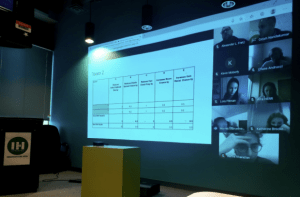The goal was to enhance the Disruptive Technology Exercise (DTEX) format by integrating a simulation that mimicked how disinformation spreads.
The North Atlantic Treaty Organization’s (NATO) Innovation Hub successfully tested its first simulation-based wargame on Monday at its facility on the Old Dominion University (ODU) campus in Norfolk, Virginia, USA. The experiment was organized in partnership with the NATO Centre for Maritime Research and Experimentation (CMRE), located in Italy, and the ODU Institute for Innovation & Entrepreneurship (ODU IIE). The experiment involved the Innovation Hub’s newly developed Disruptive Technology Experiment (DTEX) – a wargame designed to test ideas and technologies that can solve NATO’s problems. This DTEX explored 20 technological solutions that can potentially counter or mitigate disinformation campaigns. These technologies were evaluated in the context of scenarios involving COVID19. The experiment’s primary goal was to test how a simulation can be integrated with DTEX gameplay.
“This effort is the first step in developing new capabilities that will enable the Innovation Hub to test ideas and solutions within synthetic environments,” said Serge Da Deppo, manager of the Innovation Hub. “This year, we have had successful multilateral collaborations on multiple projects, and we plan to do more experiments and events next year,” he said, referring to the DTEX program and other collaborative efforts between ODU, NATO ACT, and NATO CMRE.
“We are excited about the DTEX program and developing its capability to quickly evaluate technologies and solutions in a distributed manner. This event was truly cross-disciplinary, combining the expertise of the Innovation Hub and CMRE, with ODU’s capabilities in innovation management, gaming, global policy, and cybersecurity,” said Jerry Cronin, executive director at ODU IIE. “We look forward to future collaborations with CMRE next year, including topics related to its core focus area – Maritime Research,” he said.
“Using a simulation that mimics the spread of disinformation allows participants to understand the dynamics of the problem much better,” said ODU IIE’s Girish Nandakumar, the Chief Architect of DTEX Project, who also designed and led this experiment. “Working with CMRE and the Innovation Hub on this project has been a great learning experience,” he added.
Participants included members from the Atlantic Council’s Digital Forensics Research Lab and students from various ODU programs who filled roles as facilitators and players. “Disinformation is a challenge that affects all realms of life. Finding effective countermeasures to disinformation is imperative. With an overarching threat like this, an interdisciplinary counterapproach is necessary. This DTEX put together professionals and graduate students from very different backgrounds, all of whom have a unique perspective that must be taken into account for successful addressing hybrid threats connected with disinformation,” said Afra Herr, one of the participants. The experiment also included observers from the NATO Headquarters in Brussels and the Swiss Army’s Science and Technology Division.


